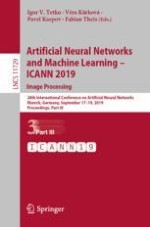2019 | Buch
Artificial Neural Networks and Machine Learning – ICANN 2019: Image Processing
28th International Conference on Artificial Neural Networks, Munich, Germany, September 17–19, 2019, Proceedings, Part III
herausgegeben von: Igor V. Tetko, Dr. Věra Kůrková, Pavel Karpov, Prof. Fabian Theis
Verlag: Springer International Publishing
Buchreihe : Lecture Notes in Computer Science
